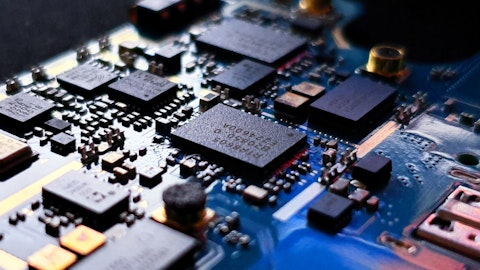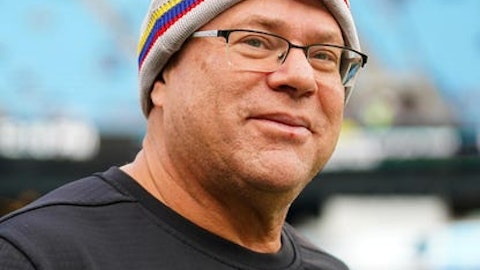Now AI’s got a bigger head of steam than it was back then. The optics piece is higher and we’ve made significant progress now on new product development in terms of getting the chips actually taped out and through the fab and now starting to think about ramping. But what I would say is, and I’ve been saying this to investors for about 6 months, we are not in a position to call the ball just yet on how big the custom silicon opportunity can be for next year. It’s still early, Vivek. I understand the investor appetite for this. I would say between us and our customers, we’re not fully — we don’t fully know how big this can be yet. So I’m going to need a little bit more time to probably size that for you. But what I can say is from when we first talked about AI 2 quarters back and what the opportunity was looking out to next year, it’s much, much higher.
And that’s both on the custom side as well as on the optic side. So I hope that helps. I understand the question, but it’s a pretty dynamic market as you see what’s going on. But the good news is it’s all moving in a very positive and upward direction.
Operator: The next question comes from Harsh Kumar of Piper Sandler. Please go ahead.
Harsh Kumar : Yes. Thanks guys. Great tremendous execution and very choppy environment. So Matt, a question for you was on the carrier side, you’re guiding down significantly down mid-40s on a sequential basis. And I think you mentioned both the wired and the wireless pieces are down. I was curious if you can help us think about perhaps what is taking the bigger part of the hit. And which one do you have more confidence in, in terms of returning back to growth first?
Matt Murphy: Yes. Thanks, Harsh. And it is a choppy environment, as you point out. Look, I think on carrier, we’re coming off a very, very strong Q3. It was over $300 million. And I think if you just kind of infer the whole year, it’s going to be — have been like a $1 billion business for Marvell. So I think that’s been a success story for us. Clearly, some — and we’ve been trying to signal if you go back over the last couple of calls, we’ve attempted to signal to investors the fourth quarter that there would be — that sort of the third quarter would be the peak of 5G stuff, and then it would take some time for that to judge that through. And we bucked the trend, if you remember, on our performance here. So both of those are — that carrier segment is a strong segment for Marvell.
It will return over time, back to a normalized run rate, but it’s very lumpy and volatile as carrier usually is. What I would say on the timing, I think they’re both going to come back. It’s just — it’s hard to know exactly when on these. I think the predictability in the segment is tough. So I don’t think I have an exact answer on which one comes back sooner. I’d say wire has been trending down for some time as I think some of that pandemic led infrastructure build has waned. The carrier 5G stuff has really performed extremely well for us this year. And by the way, when it does come back, both on the carrier on the wireless and wired side, we have incremental design wins in those segments. One is incremental content base stations with the Layer 2 processor opportunity and also our new 800-gig DSPs for carrier — for wired infrastructure, those are going to be new revenue drivers for us when we come back out of this.
So timing is still unknown. But I would just say that this is a part of the base business of Marvell, kind of the core part of Marvell that over time will return to a normalized run rate.
Harsh Kumar: Thanks, Matt.
Operator: The next question comes from Tore Svanberg of Stifel. Please go ahead.
Tore Svanberg : Yes. Thank you Matt, you mentioned the NVIDIA and Marvell partnership, and I do appreciate the video on your website, but could you add a little bit more color on exactly what this means. I assume this is a multiyear partnership. But yes, any additional color you could share with us would be great? Thanks.
Matt Murphy: Yes. Thanks, Tore. I think yes, the video was posted today, but it really, I think, just sort of captures a very long-term working relationship between the two companies across a number of opportunities, by the way. I think we’ve had a complementary and very strong partnership with NVIDIA to really help enable them and their products. In the optical area, we’ve been working with them for some time, and this goes back even to working with Mellanox in some of their applications. So this was really a way just to, I think, highlight the years of work we’ve done together and also signify that there’s a lot of opportunity for us to kind of double down together on this AI opportunity. So we’re proud to be a partner of them and support them in their growth. That’s really what’s behind it. It’s not a new announcement or anything per se. It’s just a recognition of a long-standing cooperation between the 2 companies.
Tore Svanberg: Great. Since that was kind of a soft question, I had a question on the enterprise networking business. It sounds like the sequential decline is going to be a little bit better than what we’ve seen lately. Is that a sign that you’re starting to see stability there? Or are the order rates and the visibility is still very limited?
Matt Murphy: I’d say it’s still limited. I think it’s still coming down. And I think we’re — we want to see when the customer balance sheets get back in shape to them talk a little bit more robustly about their end market demand, strengthening before we make a call there. So we’ll have to see where enterprise IT spending really ends up, Tore, next year, given the macro. And so right now, we’re just sort of taking it week by week, and we’re monitoring what products they need and looking at their forecast for next year, and we’re trying to plan accordingly. But I’d say visibility is pretty limited at this point for the full year.
Tore Svanberg: Great. Thank you very much.
Operator: The next question comes from Ross Seymore of Deutsche Bank. Please go ahead.
Ross Seymore : Matt, I just wanted to ask about your business and perhaps a different way to split it. I think everybody is excited about the AI and the cloud is a part of it and for good reason. But if I took that out of the revenues, everything else seems to be down in your guidance, 30%, 35% year-over-year, somewhere in that range. I really just wanted to get what percentage of that, I think, is down just because of cyclicality, and it sounds like the first quarter might come down again, but should bounce back at some point versus the businesses you are just deprioritizing. So how much of a cyclical snapback whenever that happens, should we expect out of Marvell versus a focus away from some of those non-cloud areas?





